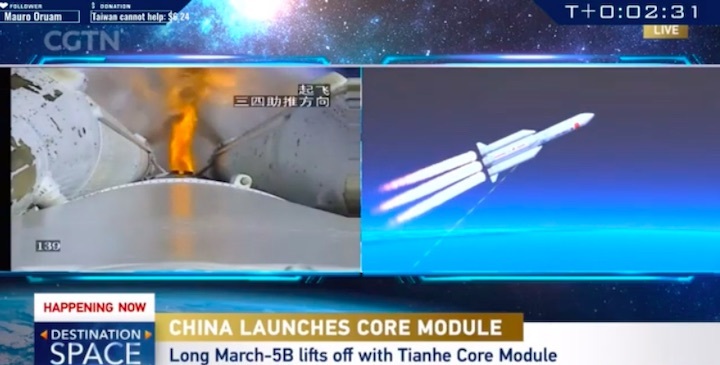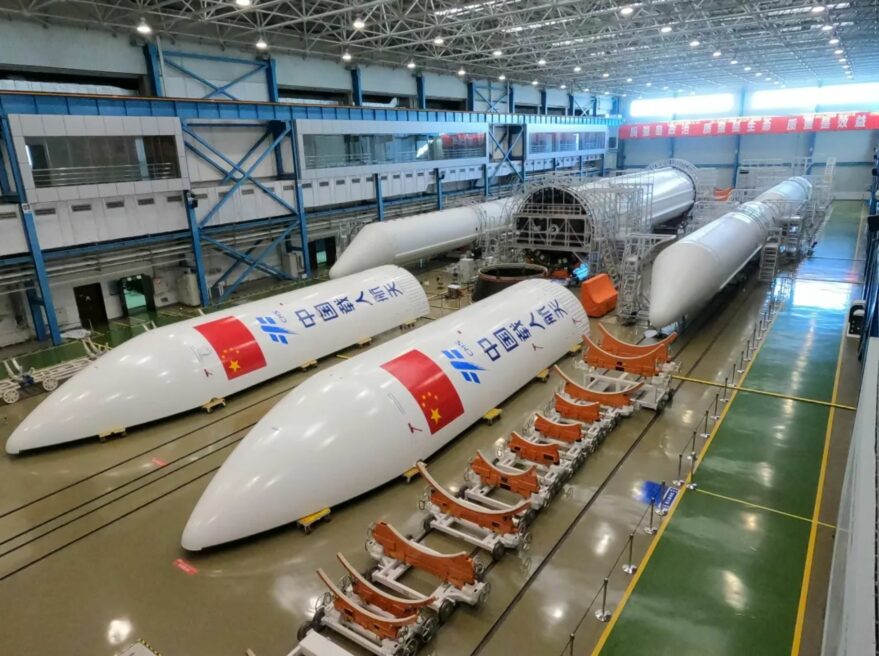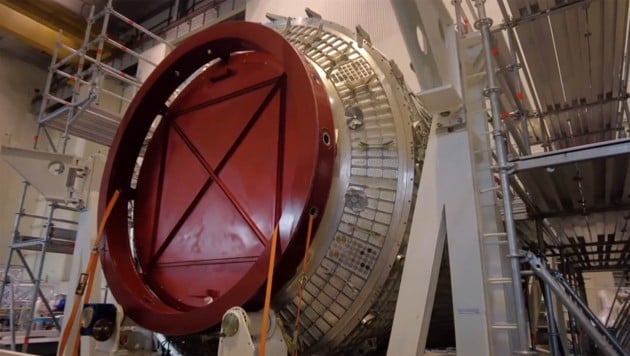4.05.2021

Nach dem Start des Kernmoduls von Chinas neuer Raumstation drohen in den kommenden Tagen Trümmer des Hauptteils der Trägerrakete „Langer Marsch 5B“ auf die Erde zu stürzen. Raumfahrtexperten warnten jetzt vor einem „unkontrollierten“ Wiedereintritt der 20 Tonnen schweren Rakete in die Erdatmosphäre.
Grund sei das Design von „Langer Marsch 5B“. Die Rakete lasse sich nach dem Start nicht mehr so steuern, um an einem vorbestimmten Punkt ins Meer zu fallen, heißt es. „Wir wissen nicht, wo“ (sie abstürzen wird, Anm.), sagte am Dienstag der Astrophysiker Jonathan McDowell vom Harvard-Smithsonian Center for Astrophysics in Cambridge im US-Bundesstaat Massachusetts.
Dürfte nur teilweise in Atmosphäre verglühen
„Im schlimmsten Fall wird es wie der Absturz eines kleinen Flugzeugs, der sich aber über Hunderte Kilometer verteilt.“ Da die Rakete sehr schnell um die Erde kreise, sei ungewiss, wann und wo genau sie in die Atmosphäre eintreten und dort teilweise verglühen dürfte, heißt es.
Schon nach dem ersten Flug des neuen besonders schweren und tragfähigen chinesischen Raketentyps „Langer Marsch 5B“ im Mai 2020 waren an der westafrikanischen Elfenbeinküste Trümmer niedergegangen und hatten mehrere Häuser in Dörfern beschädigt. „Das Design ist fahrlässig im Vergleich zu gegenwärtigen Standards anderer Länder“, kritisierte McDowell die chinesische Rakete.
Kernmodul für Raumstation ins All gebracht
Die Rakete hatte am vergangenen Donnerstag das 22 Tonnen schwere Kernmodul „Tianhe“ (Himmlische Harmonie; Bild oben) erfolgreich ins All gebracht. Damit begann die junge Raumfahrtnation den Bau seiner eigenen Raumstation. Weitere Starts sind dafür geplant. So sollen zwei weitere, 22 Tonnen schwere Module ins All gebracht und angebaut werden. Die Station soll „um 2022“ fertiggestellt werden und dann „Tiangong“ (Himmelspalast) heißen.
Wenn die technisch veraltete internationale Raumstation ISS wie geplant in den kommenden Jahren ihren Dienst einstellt, wäre China danach die einzige Nation, die einen ständigen Außenposten im Weltraum betreibt.
Quelle: krone.at
+++
‘Out-of-control’ Chinese rocket falling to Earth could partially survive re-entry
Long March 5B is doing 27,600km/h in failing orbit, with eventual crash site unknown, after launching space station hub
Part of a huge rocket that launched China’s first module for its Tianhe space station is falling back to Earth and could make an uncontrolled re-entry at an unknown landing point.
The 30-metre high core of the Long March 5B rocket launched the “Heavenly Harmony” unmanned core module into low Earth orbit on 29 April from Wenchang in China’s Hainan province.
The Long March 5B then itself entered a temporary orbit, setting the stage for one of the largest ever uncontrolled re-entries. Some experts fear it could land on an inhabited area.

“It’s potentially not good,” said Jonathan McDowell, Astrophysicist at the Astrophysics Center at Harvard University.
“Last time they launched a Long March 5B rocket they ended up with big long rods of metal flying through the sky and damaging several buildings in the Ivory Coast,” he said.
“Most of it burned up, but there were these enormous pieces of metal that hit the ground. We are very lucky no one was hurt.”
On Tuesday the core was orbiting Earth around every 90 minutes at about 27,600km/h and an altitude of more than 300km. The US military has named it 2021-035B and its path can be seen on websites including orbit.ing-now.com.
Since the weekend it has dropped nearly 80km in altitude and SpaceNews reported that amateur ground observations showed it was tumbling and not under control. This, and its speed, makes it impossible to predict where it will land when Earth’s atmosphere eventually drags it down, though McDowell said the most likely outcome is that it will fall into the sea, as the ocean covers about 71% of the planet.
But McDowell says some pieces of the rocket will survive re-entry and that it would be the “equivalent of a small plane crash scattered over 100 miles”.
Since 1990 nothing over 10 tonnes has been deliberately left in orbit to re-enter uncontrolled. The Long March 5B core stage is thought to be about 21 tonnes.
“What’s bad is that it’s really negligent on China’s part. Things more than ten tonnes we don’t let them fall out of the sky uncontrolled deliberately,” McDowell said.
Based on its current orbit the rocket is passing over Earth as far north as New York, Madrid and Beijing and as far south as southern Chile and Wellington, New Zealand, and could make its re-entry at any point within this area.
Given its velocity, a small change in its path could make a big difference to where it ends up. It’s expected to return to Earth on 10 May, plus or minus two days.
McDowell said once it’s clear the day it is returning to Earth, experts could predict its landing time within a six-hour window.
The rocket’s launch was part of 11 planned missions as part of the construction of China’s space station, which is expected to be completed in late 2022. The T-shaped space station is expected to weigh about 60 tonnes, considerably smaller than the International Space Station, which launched its first module in 1998 and weighs about 408 tonnes.
China’s space station will have a docking port and will also be able to connect with a Chinese satellite. Theoretically it could be expanded to as many as six modules.
Quelle: The Guardian
----
Update: 6.05.2021
.
Chinese rocket stage predicted to reenter atmosphere around May 8

HELSINKI — A large rocket stage that launched China’s first space station last week is likely to reenter the atmosphere around May 8, according to early space tracking predictions.
U.S. Department of Defense spokesman Mike Howard in a statement May 4 said that “U.S. Space Command is aware of and tracking the location of the Chinese Long March 5B in space, but its exact entry point into the Earth’s atmosphere cannot be pinpointed until within hours of its reentry, which is expected around May 8.”
“Until then, the 18th Space Control Squadron will be offering daily updates to the rocket body’s location on www.space-track.org beginning May 4. We will provide additional information as it becomes available,” the statement read.
The launch of the Long March 5B late April 28 Eastern successfully placed the 22.5-metric-ton Tianhe core module into orbit. However, the roughly 30-meter-tall, 5-meter-diameter Long March 5B first stage also reached orbital velocity instead of falling within a predetermined area downrange.
The empty rocket body is now in a 162 by 306-kilometer altitude orbit, according to U.S. 18th Space Control Squadron space tracking, down from an initial 170 by 372-kilometer orbit.
Without the ability to restart its engines, the core stage will be dragged towards Earth by increasing collisions with molecules in the Earth’s atmosphere. Atmospheric fluctuations and other variables and the high velocity of the stage mean that accurate predictions of when and where the stage will reenter are not possible until a few hours before the event.
The Long March 5B core stage’s orbital inclination of 41.5 degrees means the rocket body passes a little farther north than New York, Madrid, and Beijing, and as far south as southern Chile and Wellington, New Zealand, and could make its reentry at any point within this area.
A May 4 update from the Aerospace Corporation predicts reentry will occur May 9 at 12:37 a.m. Eastern (04:37 Universal time), with a margin of error of plus or minus 28 hours.
Russian space agency Roscosmos also stated May 4 that its Automated Warning System on Hazardous Situations in Outer Space (ASPOS OKP) indicated that the Long March 5B was set for an uncontrolled reentry.
Calculations by Russian experts indicate a reentry window of 9:00 p.m. May 7 to 4:00 p.m. May 9 Eastern, with more refined predictions to follow in the coming days.
China has yet to comment on the status of the Long March 5B. The country is planning 10 more launches through 2022 of various spacecraft and launch vehicles to construct its three-module space station.
China is currently preparing to send the Tianzhou-2 cargo spacecraft to Tianhe in the next few weeks using a Long March 7 rocket. A first crewed mission, Shenzhou-12, is expected to send three astronauts to the new orbital outpost in June.
Notably, two more launches of the Long March 5B are expected in 2022 to send the Wentian and Mengtian experiment modules to join Tianhe in orbit.
It is unknown if the China Academy of Launch Vehicle Technology (CALT), which designed and manufactures the Long March 5B, has planned alterations to the rocket or launch profile which would allow the core stage to either deorbit or fall to Earth on a ballistic trajectory.
The Long March 5B was designed specifically for launching modules for the Chinese space station into low Earth orbit. A test flight in 2020 also saw the core stage reach orbital velocity. That incident saw the stage reenter over the Atlantic Ocean with local reports suggesting debris from that 20-ton stage appears to have survived reentry and landed in the African nation of Côte d’Ivoire.

Holger Krag, head of the Space Safety Programme Office for the European Space Agency, told SpaceNews that an average mass of about 100 tons reenters the atmosphere in an uncontrolled way each year.
“It is always difficult to assess the amount of surviving mass and number of fragments without knowing the design of the object, but a reasonable ‘rule-of-thumb’ is about 20-40% of the original dry mass,” Krag said.
Unlike older Long March series rockets, the Long March 5B core stage uses liquid hydrogen and liquid oxygen for fuel. Older-generation Long March 2, 3 and 4 series rockets use a toxic hypergolic propellant combination of hydrazine and nitrogen tetroxide, which would make debris surviving reentry potentially hazardous to anyone approaching the wreckage.
Debris from Chinese rocket launches from inland spaceports occasionally falls within inhabited areas. China is understood to take precautions against causing injury through safety notices, evacuations and calculation of rocket stage drop zones, as well as experimenting with technologies including grid fins and parafoils.
While much attention is paid to the threat to people on the ground and aircraft in flight from satellite and rocket components reentering, the Aerospace Corporation last year raised the issue of pollution from reentry.
Quelle: SN

